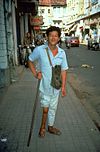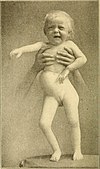Video:Polio
| Polio (Tutorial) | |
|---|---|
| Commons / NC | |
| Steps for video creation | |
| Step 1 | Preview my changes (10 sec) |
| Step 2 | Upload to Commons (10 min) |
Definition
Polio, also called poliomyelitis, or infantile paralysis, is an infectious disease caused by the poliovirus.[1]

Symptoms
Polio causes muscle weakness, resulting in an inability to move in roughly one half percent of people, who are infected with the virus.[1]

Onset of symptoms
This can occur over a few hours, to a few days.[1][2]

Areas of the body affected
The weakness most often involves the legs, but can also include the muscles of the head, neck, and diaphragm.[1]

Risk of death
Many people fully recover,[1] but there is a risk of death. About 2 to 5 percent of children, and 15 to 30 percent of adults die, if they develop muscle weakness.[1]

Minor symptoms
Another 25 percent of people infected have minor symptoms such as fever, and a sore throat, that resolve in one to two weeks[1] . Five percent have headache, neck stiffness, and pains in the arms and legs.[1][2] About 70 percent of infections have no symptoms at all.[1]

Post-polio syndrome
Years after recovery ,post-polio syndrome may occur with a slow development of muscle weakness, similar to the persons original symptoms.[3]

Spread
Poliovirus is usually spread from person to person through infected fecal matter entering the mouth, [1] from food or water containing human feces, and less commonly from infected saliva.[1][2]

Duration of infectiousness
Those who are infected may spread the disease for up to six weeks, even if no symptoms are present.[1]

Diagnosis
The disease may be diagnosed by finding the virus in the feces, or detecting antibodies against it in the blood.[1] The disease only occurs naturally in humans.[1]

Prevention
Polio is preventable with the polio vaccine; however, multiple doses are required for it to be effective.[2]

Vaccine boosters
The US Centers for Disease Control and Prevention recommends polio vaccination boosters for travelers, and those who live in countries where the disease is occurring.[4]

Treatment and current cases
Once infected there is no specific treatment.[2] In 2018, there were 33 cases of wild polio, and 103 cases of vaccine-derived polio.[5] This is down from 350,000 wild cases in 1988.[2] In 2018, the disease was only spread between people in Afghanistan and Pakistan.[5]

History
Poliomyelitis has existed for thousands of years, with depictions of the disease in ancient art.[1] The disease was first recognized as a distinct condition by the English physician Michael Underwood in 1789,[1] and the virus that causes it was first identified in 1908 by the Austrian immunologist Karl Landsteiner.[6]

History of endemic polio
Major outbreaks started to occur in the late 19th century, in Europe and the United States.[1] In the 20th century it became one of the most worrying childhood diseases in these areas.[7]

History of the polio vaccine
The first polio vaccine was developed in the 1950s by Jonas Salk.[8] In 2013, the World Health Organization hoped that vaccination efforts, and early detection of cases would result in global eradication of the disease by 2018.[9]

References
- ↑ 1.00 1.01 1.02 1.03 1.04 1.05 1.06 1.07 1.08 1.09 1.10 1.11 1.12 1.13 1.14 1.15 1.16 Hamborsky J, Kroger A, Wolfe C, eds. (2015), "Poliomyelitis", Epidemiology and Prevention of Vaccine-Preventable Diseases (The Pink Book) (13th ed.), Washington DC: Public Health Foundation, (chap. 18), archived from the original on 30 December 2016.
- ↑ 2.0 2.1 2.2 2.3 2.4 2.5 "Poliomyelitis Fact sheet N°114". who.int. October 2014. Archived from the original on 18 April 2017. Retrieved 3 November 2014.
- ↑ "Post-Polio Syndrome Fact Sheet". NIH. 16 April 2014. Archived from the original on 29 July 2011. Retrieved 4 November 2014.
- ↑ "Guidance to US Clinicians Regarding New WHO Polio Vaccination Requirements for Travel by Residents of and Long-term Visitors to Countries with Active Polio Transmission". CDC. 2 June 2014. Archived from the original on 4 June 2014. Retrieved 4 June 2014.
- ↑ 5.0 5.1 "This page allows you to request a table with AFP/polio data". WHO. Retrieved 8 March 2019.
- ↑ Daniel, Thomas M.; Robbins, Frederick C., eds. (1999). Polio (1st ed.). Rochester, N.Y.: University of Rochester Press. p. 11. ISBN 9781580460668. Archived from the original on 17 June 2016.
- ↑ Wheeler, Derek S.; Wong, Hector R.; Shanley, Thomas P., eds. (2009). Science and practice of pediatric critical care medicine. London: Springer. pp. 10–11. ISBN 9781848009219. Archived from the original on 17 June 2016.
- ↑ Aylward R (2006). "Eradicating polio: today's challenges and tomorrow's legacy". Annals of Tropical Medicine and Parasitology. 100 (5–6): 401–13. doi:10.1179/136485906X97354. PMID 16899145.
- ↑ "Global leaders support new six-year plan to deliver a polio-free world by 2018". who.int. 25 April 2013. Archived from the original on 18 October 2014. Retrieved 4 November 2014.